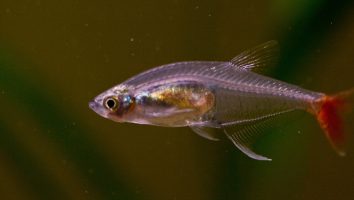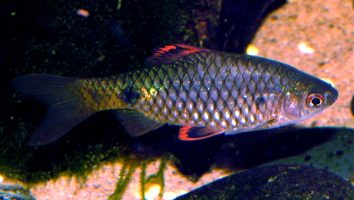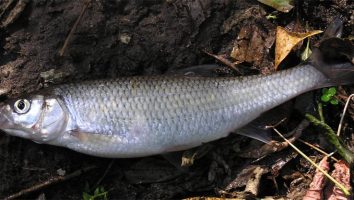Altum angelfish are a beautiful and popular freshwater fish that are known for their long fins and unique color patterns.
While they are definitely a high-maintenance fish, they are well worth the effort if you’re up for the challenge.
In this guide, we’ll teach you everything you need to know about Altum angelfish care. From diet and tank mates, to breeding and common problems.
Table of contents
Species overview
Altum angelfish (scientific name: Pterophyllum altum) are a freshwater fish that are native to the Amazon Basin in South America.
As their name suggests, these fish are primarily found in the deep waters of the basin. They are most comfortable in areas with little to no current and plenty of places to hide.
The altum angelfish is a very popular fish in the aquarium trade. They are known for their beautiful coloration and elegant fins.
Although they are a relatively peaceful fish, they can be somewhat territorial. They are also known to be one of the more difficult angelfish to care for. This is due to their specific diet and habitat requirements.
Appearance

The Altum angelfish is one of the most beautiful freshwater fish in the world. They’re known for their long fins and elegant coloration.
The body of the Altum angelfish is tall and thin. They have a long dorsal fin that runs almost the entire length of their bodies. This fin is adorned with beautiful, flowing fins.
The anal fin is similar in shape and size to the dorsal fin. Both of these fins are transparent with a slight yellowish tint.
The caudal fin is forked and also transparent. The pectoral fins are fairly large and round. The ventral fins are small and thin.
The body of the Altum angelfish is a beautiful silver color. They have vertical black stripes that run the length of their bodies. These stripes are thicker at the base of the fish and get thinner towards the tail.
The fins of the Altum angelfish are also striped. The dorsal, anal, and caudal fins have vertical black stripes. The pectoral and ventral fins are solid silver.
The face of the Altum angelfish is also striped. They have two black stripes that run from the base of their mouths to the tips of their noses. They have two small black dots on their foreheads.
Lifespan
Altum angelfish have a lifespan of 10 to 15 years.
The lifespan of an altum angelfish can vary depending on the care they receive. If they are well cared for, they can live up to 15 years. However, if they are not cared for properly, their lifespan can be significantly shortened.
Size
The average Altum angelfish size is between 6 and 8 inches, with some specimens reaching up to 12 inches. Females are typically smaller than males and have a more rounded body shape.
Tank
Tank Size
The minimum tank size for altum angelfish is 75 gallons. If you’re looking for a freshwater fish that can fit in an average-sized tank, this is not the fish for you.
If you want to keep two altum angelfish in the same tank you’ll want to add at least another 75 gallons to that minimum number if you want them to thrive.
Another reason why you need to provide enough space is for the sake of enrichment and comfort. These fish like to roam and will often run gentle but steady laps around your tank. Giving them a little bit of extra space can go a long way in making sure they can comfortably turn around in the tank.
Water Parameters
Angelfish are a very popular freshwater aquarium fish. They’re beautiful, unique, and come in a variety of colors and patterns.
But before you add angelfish to your tank, there are a few things you need to know about their care. One of the most important is their water parameters.
Angelfish are native to the Amazon River basin. That means they’re used to warm, slightly acidic water with plenty of oxygen.
While they’re adaptable to a wide range of water conditions, it’s best to stick as close to their natural habitat as possible. That way, they’re less likely to experience stress and more likely to thrive.
Here are a few water parameters to keep in mind when setting up your angelfish tank.
- Water temperature: 70 to 84 degrees Fahrenheit
- pH levels: 6.0 to 7.8
- Water hardness: 4 to 18 dGH
- Alkalinity Levels: 2-12 dKH
What To Put In Their Tank
Altum angels are one of the more difficult fish to keep in the hobby. They’re extremely sensitive to water conditions and their diet is very specific.
Because of this, we recommend that you take a more naturalistic approach when setting up their tank.
The first thing you’ll need is a good quality substrate. We prefer to use a mix of sand and gravel, but you can use all sand if you want. Just make sure it’s a fine grain so they don’t end up ingesting it.
Next, you’ll need to add some plants. These fish come from slow-moving rivers so they’re used to a lot of vegetation. We recommend using plants that are tall and slender so they have plenty of places to hide.
Java fern, water wisteria, and hornwort are all great choices. You can also use floating plants to diffuse the light a bit and help reduce stress levels.
Finally, you’ll need to add some driftwood or rocks. These fish love to hide so you’ll want to give them plenty of places to do so. Avoid anything too large though since it will make the tank feel cramped.
Common Diseases
Altum angelfish are a little more susceptible to disease than some other freshwater fish. This is mostly due to the fact that they’re quite sensitive to changes in water conditions.
The most common disease that affects this species is ich. This is a parasitic infection that will present itself as white spots on the body of your fish.
If left untreated, ich can be deadly. However, it’s relatively easy to treat if you catch it early enough.
Another disease to look out for is hole-in-the-head disease. This is an infection that is caused by poor water quality and the presence of activated carbon in your tank.
It will present itself as one or two pits/holes in the skin of your fish’s head. While it’s almost always curable, it will usually leave some scarring on your poor fish!
The best way to prevent these diseases is to simply maintain the quality of the water in your tank. A clean and stable environment is always the best way to keep your fish healthy and disease-free.
Behavior & Temperament
Altum angelfish are one of the more unique freshwater fish out there. They’re not only beautiful, but they’re also very intelligent. This is evident in their behavior, which is much different from other angelfish species.
For starters, Altum angelfish are loners. They don’t school with other fish and prefer to live by themselves. They’re also very shy fish, which is why they’re often hard to keep in captivity. They need a lot of hiding places and will often hide when they feel threatened.
Another thing that sets Altum angelfish apart from other angelfish is their feeding habits. They’re known to be picky eaters and often won’t touch food that’s been sitting in the water for too long. This is why live food is often the best way to feed them.
All of these behaviors make Altum angelfish a challenge to keep. They’re not for beginner aquarists. But, if you’re up for the challenge, they can be a very rewarding fish to have.
Tank Mates
Angelfish are some of the most popular freshwater fish for aquariums. They come in a wide range of colors and patterns, and they have unique personalities.
But not all angelfish are created equal. Some species, like the Altum angelfish, are much more difficult to care for than others.
The Altum angelfish is a large species that originates in the Amazon basin. These fish are notoriously difficult to keep in captivity, and they’re not recommended for beginners.
One of the reasons why they’re so difficult to care for is because they’re picky eaters. They’re also sensitive to water conditions and require a well-maintained aquarium.
Because of their sensitive nature, it’s important to choose the right tank mates for Altum angelfish. They can’t be kept with most other fish, and they require a peaceful environment.
Some compatible tank mates for Altum angelfish include:
- Discus Fish
- Tetras
- Angelfish
- Rainbows
- Gouramis
- Corydoras Catfish
Breeding
The altum angelfish is a beautiful fish that is not easy to breed. They are a species that is prone to getting stressed easily, so it is important to create a peaceful environment for them.
The first step to breeding altum angelfish is to set up a breeding tank. The tank should be at least 50 gallons and should have a lot of hiding places. Plants are a good option, as they will give the fish somewhere to hide.
The next step is to sex the fish. Male and female altum angelfish look very similar, but males tend to be larger. Another way to tell them apart is by looking at their fins. Males have longer fins than females.
Once you have determined the sex of the fish, you can start to set up the breeding tank. The tank should have a pH of 6.5-7.0 and a temperature of 82-86 degrees Fahrenheit.
The next step is to add the altum angelfish to the breeding tank. It is best to add a group of 5-6 fish, with 2-3 males and 3-4 females. This will give the fish a better chance of breeding.
Once the fish are in the tank, you will need to wait for them to spawn. The spawning process can take anywhere from a few days to a few weeks.
Once the fish have spawned, you will need to remove the adults from the tank. The fry will be able to feed on the eggs that are left behind.
You will need to feed the fry live food, such as baby brine shrimp or daphnia. The fry will grow quickly and will be ready to be moved to a larger tank within a few months.
Conclusion
The altum angelfish is a stunning fish that is perfect for the intermediate to advanced fish keeper. They are not recommended for beginners due to their sensitive nature and specialized care requirements.
While they may be challenging to care for, altum angelfish are definitely worth the effort. They are breathtaking fish that will add a touch of elegance to any aquarium.
If you think you are up for the challenge of caring for an altum angelfish, we say go for it! You won’t regret it.












